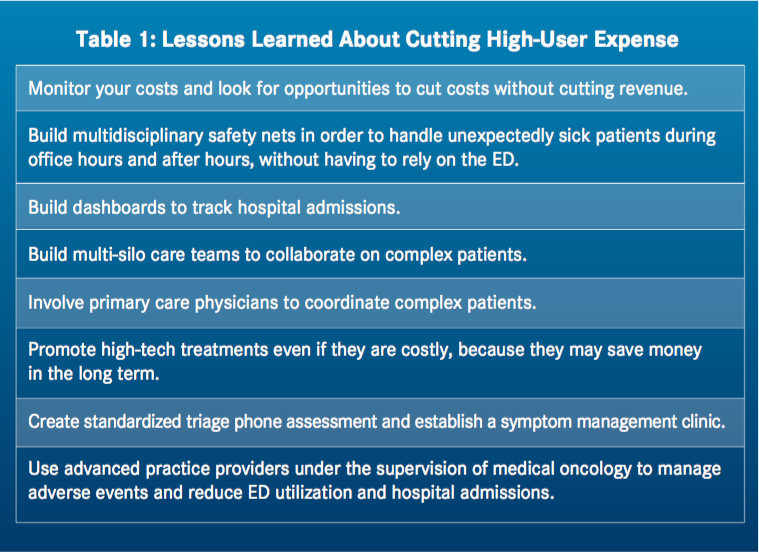Publication
Article
Oncology Business News®
High-User Focus Trims Oncology Tab
Author(s):
It was 15 years ago that Jeffrey Brenner, MD, hypothesized that patients with the highest costs in the Camden, New Jersey, healthcare system received the worst care.
Matthew A. Manning, MD

Matthew A. Manning, MD
It was 15 years ago that Jeffrey Brenner, MD, hypothesized that patients with the highest costs in the Camden, New Jersey, healthcare system received the worst care. He determined that by giving those patients special attention, care would be improved and costs would be lowered (Table 1). His theory was scoffed at, but once it went into practice, attitudes changed.
Over three years, Brenner was able to reduce hospital bills by 56% and hospital and emergency department (ED) visits by 40%. Brenner coined the term “hot spotters” to describe the high-cost patients that he focused on.
Taking a page out of Brenner’s book, the Cone Health Care Center in Greensboro, North Carolina, has managed to employ his techniques to bring down the cost of oncology care. At the Association of Community Cancer Centers 2016 National Oncology Convention, Matthew A. Manning, MD, a radiation oncologist from Cone Health, explained how he and his colleagues used claims data and CMS information to improve results. Cone Health was able to lower costs by coordinating sub-specialty care, establishing a symptom management clinic, and better integrating palliative care. These changes led to fewer hospitalizations and ED visits and lower costs of death—typical outcomes from hot spotter-type programs.

These results were achieved, in part, through Cone Health’s involvement with Triad Health Network, an accountable care organization (ACO) that ties payments to quality metrics and costs of care. The ACO seeks to ensure that proper care is delivered to patients, especially the chronically ill, at the correct time, without duplication or error. ACOs also have access to Medicare claims data, which allows them to study their patients and identify the best ways to restructure care to achieve the ACO goals of proper, quality care, and careful spending.
Cone Health managers had the hot-spotter model from Brenner to guide their efforts, but they still had to determine whom among their patients fit the description of a hot spotter. They also needed to define the characteristics of a hot spotter and decide what could be changed in order to reduce care costs.
To locate their hot spotters, Cone Health looked at 2014-2015 claims data on 21,336 Medicare beneficiaries (Table 2). Of those, 3942 had a cancer diagnosis in their CMS Hierarchical Condition Category (HCC). The patients were then separated into three cohorts based on how their annual claims compared with the ACO mean. The hot spotters were those patients with total annual claims of more than $50,000—representing 5% of the patients (216 patients total) studied at Cone Health.
However, without specific information on why patient costs were incurred, the providers were unable to create effective changes in care to reduce them. A clear profile of these specific hot spotters was needed—one that included cancer type, cancer stage, the treating oncologists, and the details of the patient’s treatment. To get all of the information required, chart reviews were performed of the hot-spotter cohort.

From that deeper understanding, the researchers realized that they needed more information about these patients than they were able to discern from the large pools of claims data. For example, a patient who had cancer and then incurred high medical costs from treatment—unrelated to that cancer could still end up on the hot-spotter list with a cancer diagnosis. To remedy this problem, the researchers created a ner lter, narrowing the 216 hot spotters to just 70 by requiring at least three visits to the cancer center within the study period.
The details of the hot-spotter patients’ medical characteristics were reported in a chart audit, which demonstrated that there was not one determining factor of a hot spotter. There wasn’t one predominant tumor type, stage of cancer, or particular physician/sub-specialist who was treating the patients.
It had been assumed that because cancer treatment is costly, cancer was behind the high expense for this small cohort of hot spotters. However, the researchers at Cone Health discovered that wasn’t the case.
Although medical characteristics couldn’t lend much insight, there were similarities in the hot spotters’ costs: of the 70 patients studied, 90% had ED visits and 60% were hospitalized. Largely, the hot spotters who ended up in the ED and hospital had multiple comorbid HCCs, most commonly dialysis/renal failure, congestive heart failure (CHF), and chronic obstructive pulmonary disease.
The researchers then studied how the costs of these patients were being generated and found programs that already at the cancer center that could be developed to “close some of the loopholes and reduce costs,” said Manning. Similarly, ED visits, hospitalizations, and the cost of death were put under scrutiny for possible economies.
Manning said that patients were ending up in the ED or hospital when they had comorbidities across “silos” because the coordination between these specialty centers was very poor. The development of cross-silo care helped to close this gap in patient management. Manning cited a Breast Cancer Heart Failure Clinic within his hospital as an example of good cross-silo management. Because women taking trastuzumab (Herceptin) are at high risk for CHF, they are prospectively referred to Cardiology for screening. This clinic reduces the risk of a patient ending up in the ED or the hospital due to a cancer-related problem.
Too many patients die in the intensive care unit because they do not have proper end-of-life care, Manning said. It was known that hospice enrollment and palliative care intervention can drastically reduce the cost of medical care in the final year of a patient’s life, as well as costs to the hospital. So, Cone Health launched a pilot study in this respect, integrating palliative care into the Brain and Spine Oncology Clinic for six months. This included an increase in goals of care, advanced directives, do-not-resuscitate orders, and hospice enrollment. In those six months, the changes led to savings of $364,000 for the hospital.
Because oncologists’ schedules are tight, many oncology patients end up in the ED when problems arise. Additionally, “large number of patients end up in the ED for pain management,” Manning said. Cone Health therefore established a Symptom Management Clinic (SMC) to offer patients with cancer a better option than relying on the ED. Under the supervision of the Medical Oncology Department, patients were seen at this clinic for pain and other symptoms related to their disease and adverse events of treatment—all serious and common conditions, but not emergencies. Manning stated that in the first year of the SMC, “Cancer patients seen in our ED were decreased by 24.5%.” Manning added that the Hospital Outpatient Quality Reporting Program has added a measure to track admissions and visits to the ED involving patients who receive inpatient chemotherapy. Poor performance, or too many ED admissions from this patient population, could result in a negative effect on a hospital’s Outpatient Prospective Payment System’s payment rate.
High-tech treatments can be costly and seem like good candidates for reducing costs. However, the benefit in care that these technologies provide is not something that patients can afford to lose, according to Manning. “Our data suggest it’s not the advanced technology that’s costing,” he said. “It’s the way we’re managing patients.” As an alternative to cutting treatments such as trastuzumab and stereotactic radiation therapy, Manning suggested that “providers can cut down spending by better managing high-cost patients.” At his hospital, providers were able to make major strides in savings without cutting any access to these treatments.
Before cutting effective, low-risk treatments, it is wise to try an integrated network of care, Manning said. Better management of patients through primary care physician involvement, multidisciplinary safety nets, and fewer ED visits can help providers to reduce costs without lowering the standard of care. All it takes, according to Manning, is careful monitoring of costs and the use of data to inform effective changes in care.
Manning MA. Collaboration across specialties to improve care and curb costs. Paper presented at: Association for Community Cancer Centers 33rd National Oncology Conference; October 2016; St. Louis, MO.









